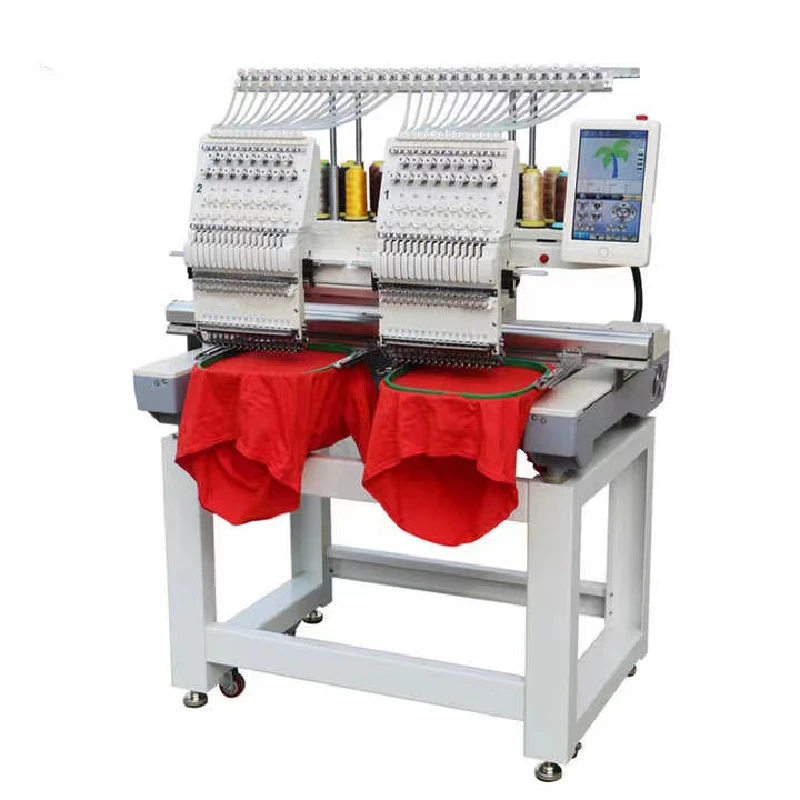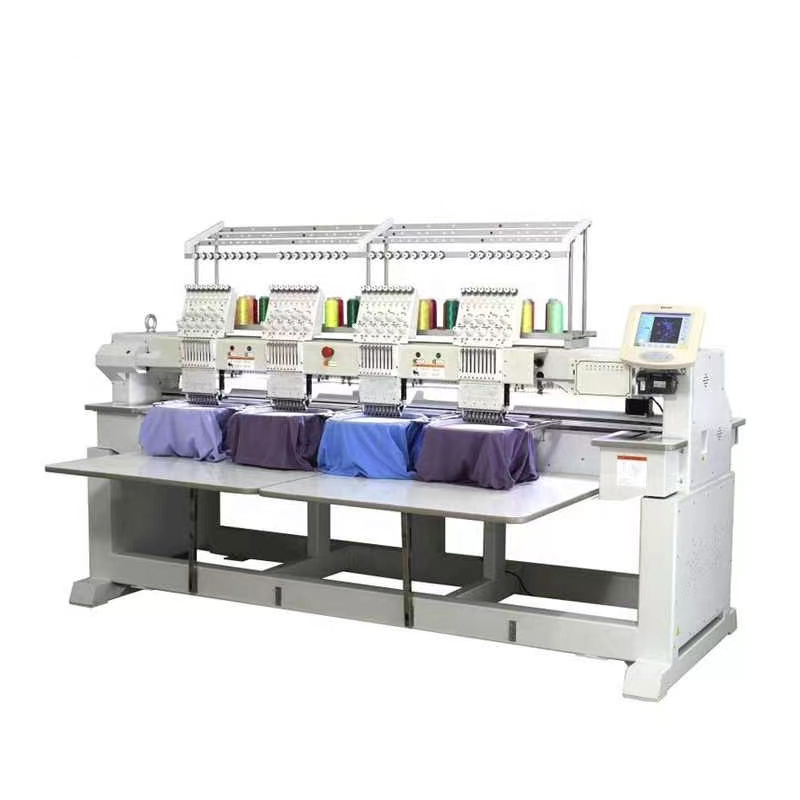Jun . 01, 2025 16:55 Back to list
High-Speed 6 Head 15 Needle Industrial Flat Embroidery Machine Supplier
- Industry impact of computerized flat embroidery machine
s - Technical advantages and design innovations
- Performance analysis: Speed vs. precision capabilities
- Supplier comparison: Specifications and capabilities table
- Customization solutions for specialized requirements
- Industrial applications and success metrics
- Strategic investment considerations

(flat embroidery machine)
The Industry Impact of Computerized Flat Embroidery Machines
Modern flat embroidery technology revolutionizes textile production, with the global embroidery machine market projected to reach $1.8 billion by 2027 according to Textile World Journal. High-speed computerized systems like 6-head configurations now process 1,500 stitches per minute (SPM), reducing average production time per unit by 78% compared to manual operations. Industrial embroidery equipment adoption has grown 15% annually since 2020, primarily driven by apparel manufacturers needing to meet fast-fashion turnaround demands. The operational efficiency gains translate to 45% lower labor costs and 30% reduced material waste, fundamentally altering production economics.
Unpacking Technical Superiority and Design Innovations
Contemporary flat machines integrate servo-motor technology providing ±0.01mm precision positioning, eliminating thread breaks during high-speed operation. Advanced tension control systems dynamically adjust to 27 different thread types, including metallic and specialty yarns. Multi-head configurations feature independent Z-axis compensation automatically adjusting for varying material thicknesses. Centralized lubrication systems maintain optimal performance through 100+ hours of continuous operation, while real-time monitoring sensors detect needle deflection as small as 0.5mm for immediate auto-correction.
Performance Analysis: Speed and Precision Capabilities
Industrial embroidery machines now achieve unprecedented synchronization between velocity and accuracy. Modern models balance 1,200-1,800 SPM operation with 0.1mm repeat positioning precision. Comparative testing reveals high-speed machines maintain consistent stitch quality up to 96% maximum operating velocity. Trimming mechanisms complete cuts within 0.3 seconds without slowing production. Independent studies confirm 15-needle configurations reduce thread change intervals by 83%, producing complex multi-color designs 60% faster than 9-needle alternatives while maintaining stitch density consistency within ±3% across entire runs.
Supplier Comparison: Technical Specifications Analysis
| Supplier Type | Production Speed | Max Design Area | Stitch Precision | Thread Capacity | Energy Consumption | Uptime Guarantee |
|---|---|---|---|---|---|---|
| High-End Specialists | 1,800 SPM | 600x500mm | ±0.05mm | 15 needles | 5.8kW | 98% |
| Mainstream Suppliers | 1,200-1,500 SPM | 400x350mm | ±0.1mm | 9-12 needles | 4.3kW | 95% |
| Value Providers | 800-1,000 SPM | 300x250mm | ±0.2mm | 6-9 needles | 3.7kW | 90% |
Customization Solutions for Specialized Requirements
Leading suppliers now offer extensive modification programs adapting machines to unique production challenges. Cap options extend from standard 6-head configurations to 12-head layouts for bulk cap production. For technical fabrics, specialized needle assemblies penetrate materials up to 8mm thick including ballistic nylon and multi-layer composites. Unconventional applications feature additional Y-axis rails accommodating 3D surfaces and cylindrical items. Software customization creates dedicated interfaces for specific designs like corporate logos with automated pattern libraries reducing programming time by 75%. Premium suppliers implement user-requested modifications within 6-8 weeks from order placement.
Industrial Applications and Success Metrics
Automotive upholstery manufacturers report 40% production increase using multi-head systems for complex dashboard embroidery. Major hotel chains standardized on automated towel emblems, processing 18,000 pieces weekly with 99.97% consistency. Footwear producers decreased logo application time from 90 to 12 seconds per shoe using specialized jig systems. Military contractors achieved 100% stitch density compliance on tactical gear using modified 15-needle configurations. Promotional products suppliers handling custom orders consistently operate machines at 92% capacity utilization with under 1% rejection rates even for 500+ color variation runs.
Future-Proofing Production with Strategic Flat Embroidery Machinery Investment
Selecting industrial flat embroidery technology requires balancing immediate production demands against long-term innovation capacity. Industry lifecycle data indicates businesses investing in modular systems maintain technological relevance 58% longer than fixed-configuration purchasers. Forward-looking operators prioritize machines accepting firmware upgrades with compatibility horizons extending 5-7 years beyond initial installation. Leading suppliers increasingly incorporate IoT connectivity enabling predictive maintenance scheduling based on 47 operational parameters, reducing unplanned downtime to under 2% annually. Production managers report 32-month ROI on advanced models through decreased rework and increased throughput of premium customized orders.

(flat embroidery machine)
FAQS on flat embroidery machine
Q: What are the key features of a high-speed computerized flat 6-head 15-needles embroidery machine?
A: This industrial embroidery machine offers high-speed stitching (up to 1,200 RPM), 6 independent heads for simultaneous designs, and 15 needles per head for multicolor patterns. Its computerized system ensures precision and supports complex designs.
Q: How do I choose a reliable flat embroidery machine supplier?
A: Evaluate suppliers based on industry experience, customer reviews, and after-sales support. Reputable flat embroidery machine suppliers typically provide warranties, training, and technical assistance for industrial-grade equipment.
Q: What maintenance does an industrial flat embroidery machine require?
A: Regular oiling of moving parts, needle replacement, and software updates are essential. High-speed computerized models also need periodic calibration to maintain stitching accuracy and prevent thread breaks.
Q: Which industries commonly use computerized flat embroidery machines?
A: These machines are ideal for apparel manufacturing, textile home goods, and promotional product industries. They efficiently handle bulk orders for garments, curtains, and branded merchandise with intricate designs.
Q: What advantages do 6-head flat embroidery machines have over single-head models?
A: The 6-head configuration increases production capacity by embroidering six items simultaneously. It reduces operational costs and time while maintaining consistent quality across all units, making it ideal for large-scale orders.
-
6 Head Embroidery Machine for Professional T-Shirt Embroidery
NewsJul.25,2025
-
High-Efficiency Computerized T Shirt Embroidery Machine for Custom Apparel
NewsJul.24,2025
-
High-Speed 12 Needle Embroidery Machine for T-Shirts & Custom Apparel
NewsJul.23,2025
-
High-Efficiency Multi Head Embroidery Machine for Custom Apparel
NewsJul.22,2025
-
Automatic Embroidery Machine: Fast, Affordable Multi-Head Solutions
NewsJul.22,2025
-
Cheap Computer Embroidery Machine Price | Pro & Cap Embroidery Deals
NewsJul.21,2025

Copyright © 2025 Xingtai Pufa Trading Co., Ltd All Rights Reserved. Sitemap | Privacy Policy
